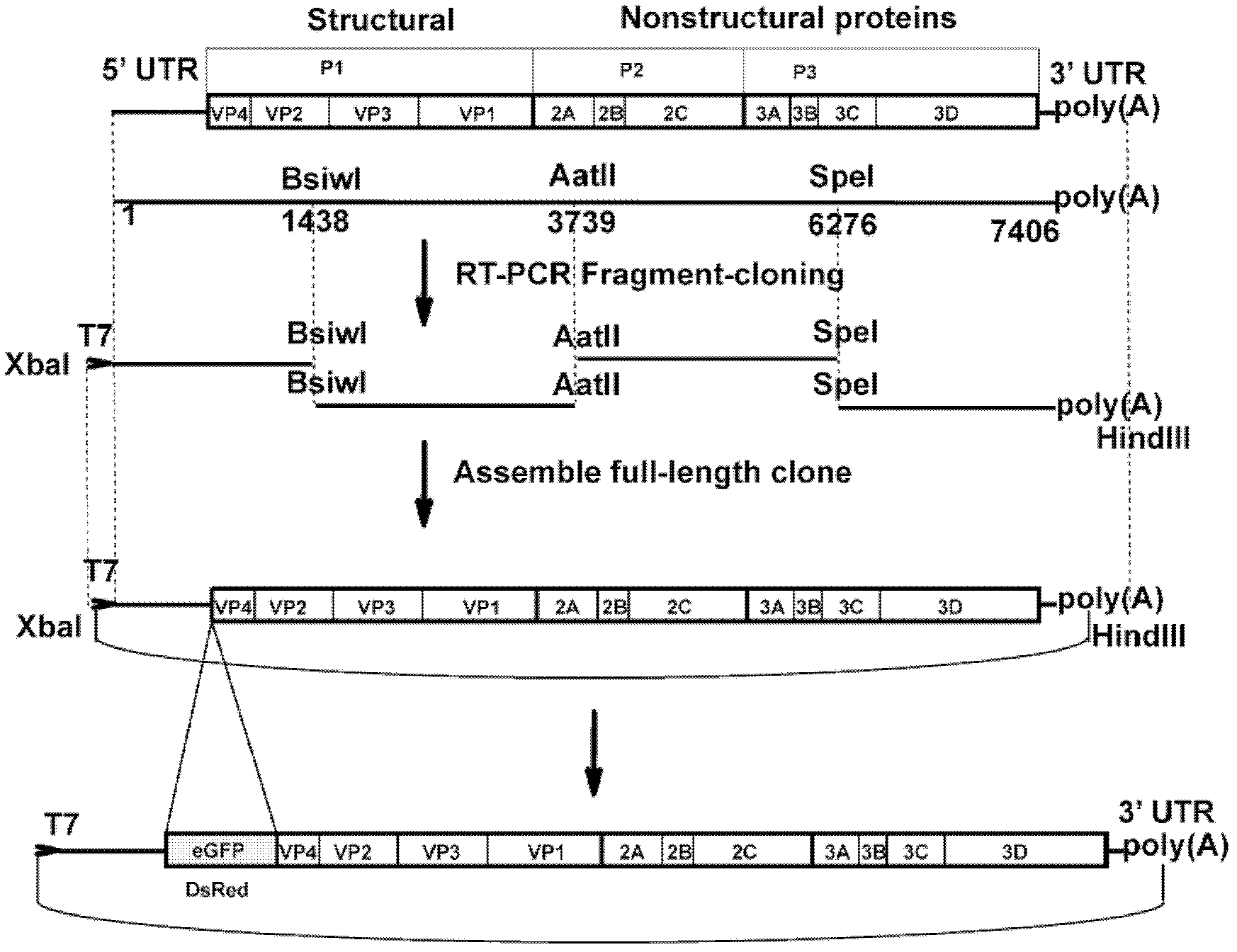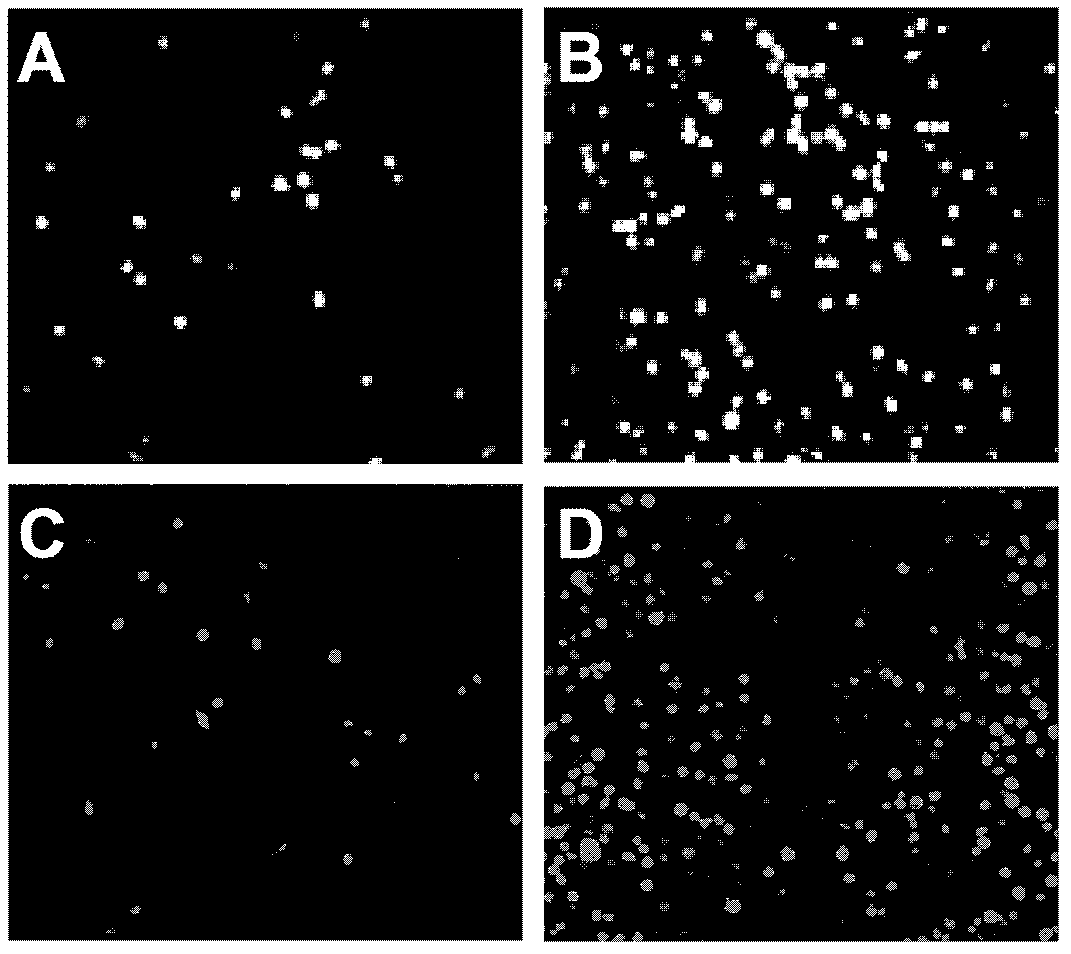Preparation method and application of enterovirus 71 type full-length infectious clone with tags
An infectious cloning and labeling technology, applied in the biological field, can solve problems such as lack of treatment methods
- Summary
- Abstract
- Description
- Claims
- Application Information
AI Technical Summary
Problems solved by technology
Method used
Image
Examples
Embodiment 1
[0097] Embodiment 1: Contain the construction of the recombinant clone of EV71 full-length gene, its steps are:
[0098] 1. Extraction of total RNA:
[0099] Get 140ul of EV71 virus liquid (mentioned above), extract the total RNA of EV71 according to the requirements of the QIAamp Viral RNA (purchased from Qiagen company) kit instructions, use Thermo Scientific NanoDrop 2000 (purchased from Thermo company) to measure the concentration of RNA, The quality of the RNA was detected by agarose gel electrophoresis at a concentration of 1% (w / v), and stored at -80°C for future use.
[0100] 2. RT-PCR amplification of EV71:
[0101] The whole genome of EV71 was divided into four parts to design primers (these four parts were named as F1, F2, F3 and F4 respectively). Using the total RNA of EV71 in the above step 1 as a template, RT-PCR kit (purchased from Takara Company) was used to obtain DNA fragments F1, F2, F3 and F4 respectively. The sequences of fragments F1-F4 are shown in SE...
Embodiment 2
[0145] Embodiment 2: the application of the full-length infectious clone of EV71 with eGFP and DsRed tags in the ability to prepare EV71 virus, the steps are:
[0146] 1. Linearization of plasmids: Take 10 μg of plasmids pACYC177-EV71-eGFP-FL and pACYC177-EV71-DsRed-FL, digest with XbaI (described above), and then add 100 μl of saturated phenol (purchased from Sinopharm Group Chemical Reagent Company), mix well, centrifuge at 17000g for 5min, draw the upper layer liquid into a new centrifuge tube, and add 100μl sterile water to the original centrifuge tube to mix, centrifuge at 17000g for 5min; absorb the upper layer liquid and combine with the liquid obtained in the previous step ( The total volume is about 200 μl), add 200 μl chloroform (purchased from Sinopharm Chemical Reagent Company) and mix well, centrifuge at 17,000 g for 5 min; draw the upper layer into a sterile imported centrifuge tube (about 100 μl), add 10 μl of pH5.2, 3mol / l Sodium acetate (purchased from Sinoph...
Embodiment 3
[0150] Example 3: The full-length infectious clone of EV71 with eGFP and DsRed tags has the ability to produce EV71 stably carrying eGFP and DsRed genes respectively, and the steps are:
[0151] 1. Inoculate 3×10 cells in a 6-well cell culture plate 5 Vero cells, when the confluence reached 60-70%, the RNA of pACYC177-EV71-eGFP-FL and pACYC177-EV71-DsRed-FL transcribed in vitro were respectively collected by DMRIE-C reagent 48h after transfection (P0 generation) and stored at -80°C; then the P0 generation viruses were respectively infected with Vero cells, and the viruses (P1 generation) were collected 60 hours after infection, and stored at -80°C; the P1 generation viruses were respectively infected with Vero cells, and 60 hours after infection The virus (P2 generation) was collected and stored at -80°C; the P2 generation virus was respectively infected with Vero cells, and the virus (P3 generation) was collected 60h after infection, and stored at -80°C; the P3 generation vir...
PUM
 Login to View More
Login to View More Abstract
Description
Claims
Application Information
 Login to View More
Login to View More - R&D
- Intellectual Property
- Life Sciences
- Materials
- Tech Scout
- Unparalleled Data Quality
- Higher Quality Content
- 60% Fewer Hallucinations
Browse by: Latest US Patents, China's latest patents, Technical Efficacy Thesaurus, Application Domain, Technology Topic, Popular Technical Reports.
© 2025 PatSnap. All rights reserved.Legal|Privacy policy|Modern Slavery Act Transparency Statement|Sitemap|About US| Contact US: help@patsnap.com



